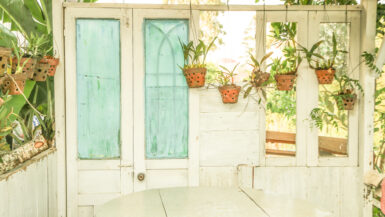Indoor vertical herb gardening has gained significant popularity recently as urban dwellers seek innovative ways to incorporate fresh, homegrown herbs into their daily lives. The practice saves space and adds aesthetic appeal to one’s home while providing numerous health benefits.
This article will explore various indoor vertical herb garden ideas and tips, covering aspects such as choosing the right plants, selecting suitable vertical garden systems, and ensuring optimal growth conditions.
Whether you’re an experienced gardener or a beginner exploring this sustainable practice, this comprehensive guide will equip you with the knowledge to create a thriving, space-efficient indoor vertical herb garden.
DIY Indoor Vertical Herb Garden Ideas For Your Projects
Creating a DIY indoor vertical herb garden can be an exciting and fulfilling project that allows you to customize the design and plant selection to your preferences. This section will explore several DIY indoor vertical herb garden projects catering to various skill levels and spatial requirements. These projects will inspire you to exercise your creativity and transform your living space into a verdant haven teeming with fresh herbs.
Repurpose a Wooden Pallet
One of the most straightforward DIY indoor vertical herb garden projects involves transforming a wooden pallet into a rustic, space-saving garden. You’ll need a wooden pallet, landscape fabric, a staple gun, and potting soil to do this.
Start by attaching the landscape fabric to the back and sides of the pallet, creating a pocket. Fill the pallet with potting soil and plant your herbs in the gaps between the slats. Learn the pallet against a wall or mount it for a charming and functional vertical herb garden.
Build a Hanging Mason Jar Garden
A hanging mason jar garden is an aesthetically pleasing and easy-to-create indoor vertical herb garden project. For this project, you will need mason jars, metal clamps, a wooden board, mounting hardware, and your choice of herbs. Attach the metal clamps to the wooden board at equal intervals, then mount the board to a wall or suspend it from the ceiling.
Secure your potted herbs in the mason jars in the clamps. This project creates a visually stunning display that allows you to grow and showcase your herbs in a compact, space-saving manner.
Design a Wall-Mounted Planter System
For those seeking a more modern and sleek approach, a wall-mounted planter system is an excellent indoor vertical herb garden project. You can purchase modular wall planters or create your own using plastic containers, metal trays, or even repurposed gutters.
Mount the planters on your wall in a grid or staggered pattern to create a visually captivating display. This project is visually appealing and highly practical, as it can be easily adapted to fit your available wall space.
Utilize a Bookshelf or Ladder
Repurposing a bookshelf or ladder can be a creative and cost-effective way to create an indoor vertical herb garden. Arrange potted herbs on the shelves or steps of the bookshelf or ladder, ensuring each plant receives adequate light. This project is perfect for those with limited wall space, as it maximizes your vertical space without requiring any mounting or hanging.
Indoor Vertical Garden Ideas for the Kitchen Space
For a more in-depth guide on incorporating vertical herb gardens into your kitchen, check out our article “Indoor Vertical Garden Ideas for the Kitchen Space.” This resource has additional ideas and tips to help create a functional, space-saving vertical herb garden in your kitchen.
These DIY indoor vertical herb garden projects promote sustainable living and add a touch of greenery and vitality to your home. You can create a unique, thriving indoor garden that suits your style and space by experimenting with different designs and plant selections.
Benefits of Growing Herbs in Vertical Gardens
Indoor vertical herb gardens offer many advantages, from space efficiency and aesthetic appeal to improved air quality and well-being. In this section, we delve into the numerous benefits of growing herbs in vertical gardens and explore how cultivating your herbs indoors can improve your lifestyle and living space.
Space-Saving Solution for Urban Dwellers
One of the most significant benefits of an indoor vertical herb garden is its ability to maximize limited space. Growing herbs vertically for urban dwellers with small apartments or balconies allows you to cultivate various plants without sacrificing precious floor space. This space-saving solution enables you to enjoy the freshness and fragrance of homegrown herbs, even in the most compact living environments.
Enhanced Aesthetic Appeal and Customization
Indoor vertical herb gardens can transform dull walls and corners into vibrant, living works of art. With many design options, you can create a unique and visually captivating display that complements your home’s interior design. A vertical garden style suits every taste and preference, from rustic wooden pallets to sleek wall-mounted planters.
Improved Air Quality and Well-being
Growing herbs indoors can positively impact your air quality and overall well-being. Plants are natural air purifiers, filtering out toxins and releasing oxygen into your living space. Herbs can also elevate your mood and reduce stress, as their fragrances are associated with relaxation and mental clarity. Cultivating an indoor vertical herb garden creates a healthier and more pleasant living environment.
Convenient and Sustainable Access to Fresh Herbs
An indoor vertical herb garden constantly supplies fresh, pesticide-free herbs at your fingertips. This convenience enhances your culinary experiences and encourages you to adopt a more sustainable lifestyle by reducing reliance on store-bought herbs. With your herbs within arm’s reach, you can enjoy fresh herbs’ flavor and health benefits in your meals all year round.
Education and Connection to Nature
Cultivating an indoor vertical herb garden can be an excellent learning opportunity for children and adults. It fosters an understanding of plant growth, care, and the importance of sustainable practices. Additionally, tending to your herb garden can help you develop a deeper connection to nature, promoting mindfulness and a greater appreciation for the natural world.
In summary, growing herbs in vertical gardens offer many benefits, making it ideal for individuals seeking to enhance their living spaces, health, and lifestyles. From maximizing space and beautifying interiors to improving air quality and fostering a connection to nature, indoor vertical herb gardens are a fantastic addition to any home.
Essential Vertical Herb Garden Care Tips
It’s crucial to provide your plants with the appropriate care and attention to ensure the success and longevity of your indoor vertical herb garden. This section will explore essential vertical herb garden care tips to help you maintain a thriving, healthy garden. From selecting the right plants to providing optimal growing conditions, these care tips will equip you with the knowledge and confidence to nurture your indoor vertical herb garden.
Choosing the Right Herbs for Your Indoor Garden
Selecting suitable herbs for your indoor vertical garden is a critical first step. Opt for herbs that thrive in similar light and moisture conditions to ensure a harmonious environment. Some popular herbs for indoor gardening include basil, chives, cilantro, mint, oregano, parsley, rosemary, and thyme. Be mindful of each herb’s growth habits, as some, like mint, can be invasive and require containment within a separate container.
Providing Adequate Light and Temperature
Herbs typically require at least 6-8 hours of bright, indirect sunlight per day. South or southwest-facing windows are ideal locations for your indoor vertical herb garden. If natural light is insufficient, consider supplementing with grow lights. Monitor the temperature of your indoor garden, as most herbs prefer a consistent temperature between 65-75°F (18-24°C) during the day and slightly cooler at night.
Ensuring Proper Watering and Humidity
Watering is a critical aspect of indoor herb garden care. Most herbs prefer moderately moist soil, so watering them regularly without overwatering is essential. The frequency will depend on factors such as container size, type of soil, and ambient humidity. To prevent root rot, ensure your containers have drainage holes and avoid letting your herbs sit in standing water. Additionally, maintain adequate humidity levels by misting your plants or placing a water tray near your garden to create a more humid microclimate.
Using the Right Soil and Fertilizer
Herbs require well-draining, nutrient-rich soil to thrive. Opt for a high-quality potting mix designed for indoor herbs or container gardening. Regularly check the soil’s nutrient levels and supplement with an organic, slow-release fertilizer. Be cautious not to over-fertilize, as this can lead to excessive growth and diminished flavor in your herbs.
Pruning and Harvesting Your Herbs
Regular pruning and harvesting will encourage bushier growth and prevent your herbs from becoming too leggy or sparse. Pinch back the tips of your herbs to promote branching and remove any dead or yellowing leaves. When harvesting, avoid removing more than one-third of the plant at a time to prevent stressing the herbs and ensure a continuous supply of fresh foliage.
Monitoring for Pests and Diseases
Keep a close eye on your indoor vertical herb garden for signs of pests or diseases. Pests such as aphids, spider mites, and whiteflies can be controlled with insecticidal soap or neem oil. Practice good hygiene by promptly removing any dead or diseased plant material and isolating affected plants to prevent the spread of pathogens.
By implementing these essential vertical herb garden care tips, you’ll be well on your way to cultivating a lush, vibrant indoor garden. With diligent attention to your herbs’ needs and a little patience, your indoor vertical herb garden will reward you with a steady supply of fresh, aromatic herbs to enhance your culinary creations and brighten your living space.
Choosing the Perfect Herbs for Vertical Gardens
Selecting the ideal herbs for your indoor vertical garden is crucial for creating a harmonious, thriving environment. This subsection will discuss the factors to consider when choosing herbs and some popular and versatile options well-suited for vertical gardening. By carefully selecting your plants, you can create a stunning and productive indoor vertical herb garden that caters to your culinary and aesthetic preferences.
Factors to Consider When Selecting Herbs
When choosing herbs for your indoor vertical garden, consider light requirements, growth habits, and compatibility. Select herbs requiring similar lighting conditions to ensure all plants receive the necessary light. Be mindful of each herb’s growth habits, choosing compact or cascading growth patterns to maximize vertical space. Opt for herbs with similar moisture and temperature preferences to create a cohesive environment conducive to healthy growth.
Popular Herbs for Indoor Vertical Gardens
The following herbs are commonly grown in indoor vertical gardens due to their adaptability, compact growth habits, and versatility in cooking:
1. Basil: This popular culinary herb thrives in bright, indirect light and consistently moist soil. Basil is available in many varieties, from sweet Italian to Thai, allowing you to experiment with different flavors in your dishes.
2. Chives are hardy, low-maintenance herbs that require moderate light levels and well-drained soil. Their mild onion flavor makes them versatile in salads, soups, and baked dishes.
3. Cilantro: Cilantro’s unique, refreshing flavor is ideal for Mexican, Thai, and Indian dishes. It requires bright, indirect light and consistently moist soil. As it has a short life cycle, be prepared to replant cilantro regularly.
4. Mint: Mint is a popular aromatic herb that thrives in moderate to bright light and consistently damp soil. Due to its invasive nature, consider planting mint in a separate container to prevent it from overtaking other herbs.
5. Oregano: This Mediterranean herb is an Italian and Greek cuisine staple. It requires bright light and well-draining soil, and its compact growth habit makes it suitable for vertical gardens.
6. Parsley: Parsley is a versatile herb that requires moderate to bright light and consistently moist soil. It is available in curly and flat-leaf varieties, which are excellent additions to various dishes.
7. Rosemary: This woody, aromatic herb thrives in bright light and well-draining soil. Its upright growth habit makes it suitable for indoor vertical gardens.
8. Thyme: Thyme’s delicate, earthy flavor complements a variety of dishes. It requires bright light and well-draining soil. Its low-growing habit and trailing varieties make it an attractive addition to vertical gardens.
Selecting These Herbs
You can select the perfect combination of herbs for your indoor vertical garden by considering light requirements, growth habits, and compatibility. These popular and versatile options create a stunning display and enrich your culinary experiences with diverse flavors and aromas. With the proper selection of herbs, your indoor vertical garden will become a vibrant and productive green space that enhances your home and lifestyle.
Space Saving Indoor Vertical Garden Designs
Incorporating a vertical garden into your living space can be a game-changer for those who lack the luxury of ample square footage. Vertical gardens save space and add a touch of greenery and style to your home. This section will explore various space-saving indoor vertical garden designs that effectively utilize vertical space and cater to different styles and preferences. These designs range from simple DIY projects to more complex structures, ensuring a space-saving solution for every home and gardener.
Wall-mounted planters and Shelves
A popular space-saving vertical garden design involves using wall-mounted planters and shelves. This design allows you to use unused wall space, creating a visually appealing display of herbs without encroaching on your floor area. Wall-mounted planters come in various materials and styles, from sleek metal grids to rustic wooden boxes. Alternatively, you can use floating shelves or repurpose existing shelving units to create a tiered display of potted herbs.
Ladder-style Plant Stands
Ladder-style plant stands are an excellent space-saving solution that combines style with functionality. This vertical garden design features a series of shelves or platforms at varying heights, mimicking the appearance of a ladder. Ladder-style plant stands can be purchased or constructed using repurposed materials, such as wooden pallets or old ladders. This design maximizes vertical space and adds visual interest to your indoor garden.
Hanging Pocket Planters
Hanging pocket planters are a versatile, space-saving indoor vertical garden design that adapts quickly to various room layouts and plant preferences. These planters consist of fabric or plastic pockets attached to a support structure, such as a wooden frame or metal rod. They can be suspended from the ceiling or mounted on a wall, providing a flexible and visually captivating solution for growing herbs in tight spaces.
Trellises and Vertical Garden Panels
For those seeking a more structured and architectural approach, trellises and vertical garden panels offer an attractive, space-saving vertical garden design. These structures can be either freestanding or wall-mounted, often constructed from metal, wood, or plastic. Trellises and vertical garden panels support climbing or trailing herbs, creating a lush, green backdrop that saves space and adds aesthetic appeal to your living area.
Stacked Planters and Tiered Pots
Stacked planters and tiered pots are inventive space-saving solutions that allow you to grow multiple herbs in a compact, vertical arrangement. This design involves placing planters or pots on top of one another in a straight column or a staggered configuration.
Stacked planters and tiered pots can be purchased as a complete system or created using a combination of pots and stands. This vertical garden design effectively utilizes vertical space while adding depth and dimension to your indoor garden.
Explore these various space-saving indoor vertical garden designs to find the perfect solution to accommodate your needs. Each design offers a unique approach to maximizing vertical space. They add greenery to your home, transforming even the tiniest living areas into a thriving indoor oasis. With thoughtful planning and creativity, you can create a space-efficient indoor vertical herb garden that enhances your living space’s aesthetics and functionality.







Leave a reply